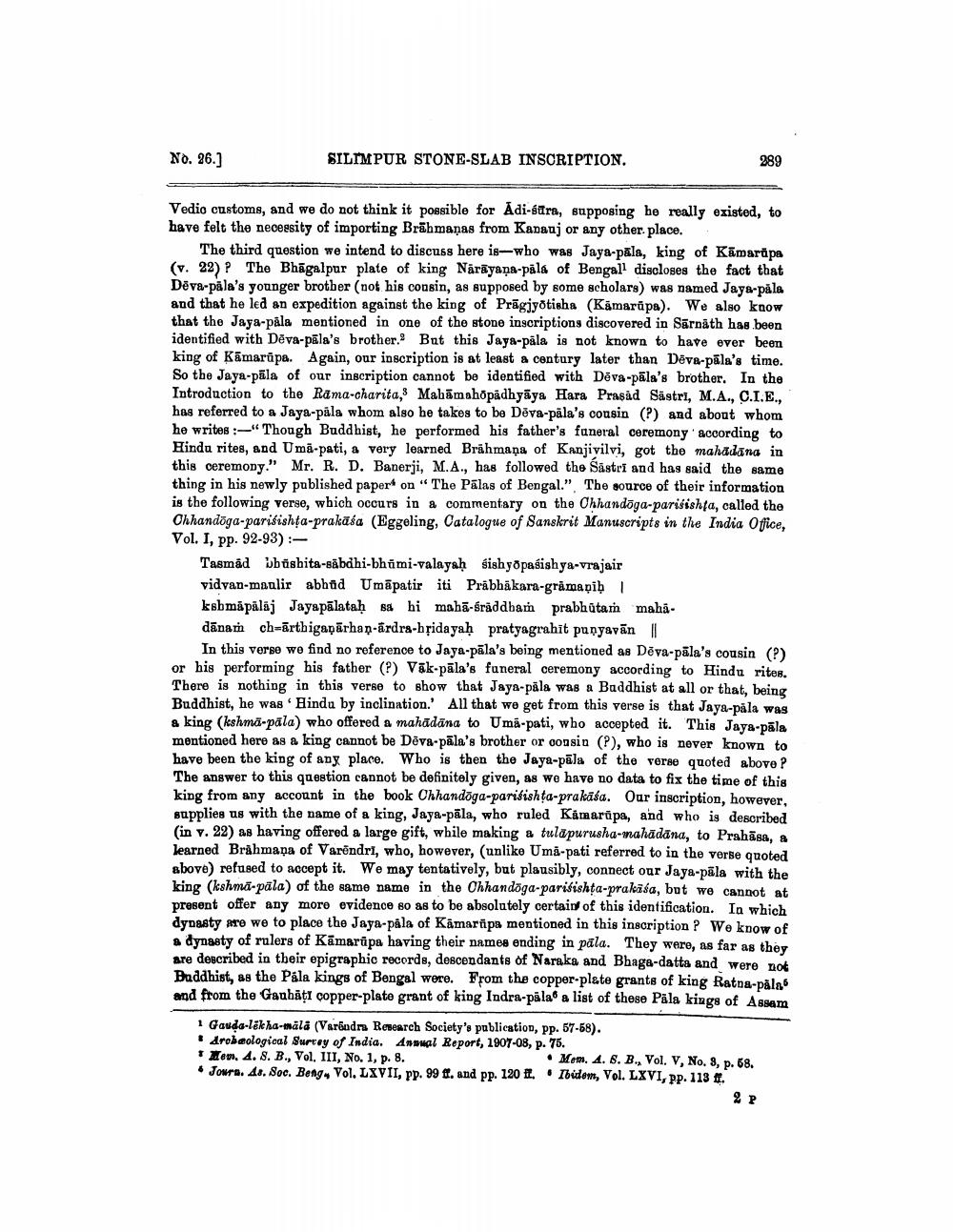________________
No. 26.]
SILIMPUR STONE-SLAB INSCRIPTION.
289
Vedio customs, and we do not think it possible for Adi-stra, supposing he really existed, to have felt the necessity of importing Brāhmaṇas from Kapauj or any other place.
The third question we intend to discuss here is-who was Jaya-pala, king of Kāmarüpa (v. 22) ? The Bhāgalpur plate of king Nārāyana-påla of Bengali discloses the fact that Dēva-påla's younger brother (not his cousin, as supposed by some scholars) was named Jaya-påla and that he led an expedition against the king of Prāgjyotisha (Kämarüpa). We also know that the Jaya-pala mentioned in one of the stone inscriptions discovered in Sarnath has been identified with Dēva-pāla's brother. But this Jaya-päla is not known to have ever been king of Kāmarūpa. Again, our inscription is at least a century later than Déva-pāla's time. So the Jaya-pila of our inscription cannot be identified with Déva-pāla's brother. In the Introduction to the Rama-charita, Mahāmshopadhyāya Hara Prasad Süstri, M.A., C.I.E., has referred to a Jaya-pala whom also be takes to be Déva-pala's cousin (?) and about whom he writes : -" Though Buddhist, he performed his father's faneral ceremony according to Hinda rites, and Umā-pati, & very learned Brāhmaṇa of Kanjivilvi, got the mahadāna in this ceremony." Mr. R. D. Banerji, M.A., has followed the Sastri and has said the same thing in his newly published paper on "The Pālas of Bengal.". The source of their information is the following verse, which occurs in a commentary on the Chhandöga-parisishta, called the Ohhandöga-parisishta-prakasa (Eggeling, Catalogue of Sanskrit Manuscripts in the India Office, Vol. I, pp. 92-93) -
Tasmad būghita-Bābdhi-bhūmi-valayah sishy pasishya-vrajair vidvan-maulir abhud Umāpatir iti Prabhakara-grimapih kshmäpälaj Jayapālataḥ sa hi mabā-sräddbam prabhūtam mahidānam ch-arthigaņārhan-ārdra-hridayaḥ pratyagrahit punyavān ||
In this verse we find no reference to Jaya-pāla's being mentioned as Déva-pāla's cousin (?) or his performing his father (?) Vāk pāla's funeral ceremony according to Hindu rites. There is nothing in this verse to show that Jaya-pāla was a Baddhist at all or that, being Buddhist, he was Hindu by inclination. All that we get from this verse is that Jaya-pala was & king (kshmä-pala) who offered a mahādāna to Uma-pati, who accepted it. This Jaya-pāla mentioned here as a king cannot be Déva-pāla's brother or cousin (?), who is never known to have been the king of any place. Who is then the Jaya-pāla of the verse quoted above ? The answer to this question cannot be definitely given, as we have no data to fix the time of this king from any account in the book Chhandoga-parisishta-prakāša. Our inscription, however, supplies us with the name of a king, Jaya-pāla, who ruled Kamarūpa, and who is described (in v. 22) as having offered a large gift, while making a tulapurusha-mahādana, to Prahāsa, a learned Brahmana of Varēndri, who, however, (unlike Umå-pati referred to in the verse quoted above) refused to accept it. We may tentatively, but plausibly, connect our Jaya-pāla with the king kshma-pala) of the same name in the Chhandöga-parifishta-prakasa, but we cannot at present offer any more evidence so as to be absolutely certains of this identification. In which dynasty are we to place the Jaya-påla of Kamarapa mentioned in this inscription? We know of a dynasty of rulers of Kāmarapa having their names ending in pala. They were, as far as they are described in their epigraphic records, descendants of Naraka and Bhaga-datta and were not Baddhist, as the Påla kings of Bengal were. From the copper-plate grants of king Ratna-påla and from the Gauhati copper-plate grant of king Indra-palao a list of these Päla kings of Assam
1 Gauda-lakha-mala (Varindra Research Society's publication, pp. 57-58). #drobaological Survey of India. Ansal Report, 1907-08, p. 75. Len, 4. 8. B., Vol. III, No. 1, p. 8.
• Mom. 4. 8. B., Vol. V, No. 8, p. 68. • Jours. 41. 800. Bong, Vol. LXVII, pp. 99 f. and pp. 120 t. . Ibidom, Vol. LXVI, PP. 113 .




